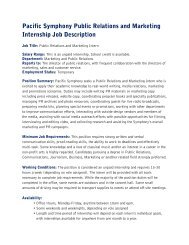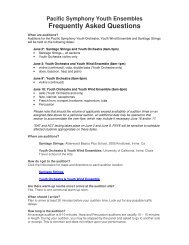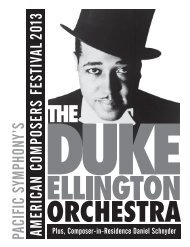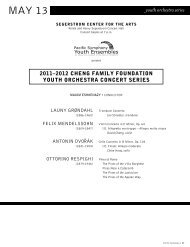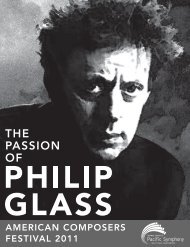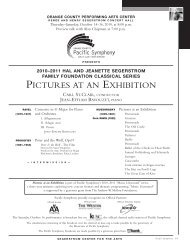Program Notes - Pacific Symphony
Program Notes - Pacific Symphony
Program Notes - Pacific Symphony
Create successful ePaper yourself
Turn your PDF publications into a flip-book with our unique Google optimized e-Paper software.
NOTES<br />
Piotr Ilyich Tchaikovsky<br />
(1840–1893)<br />
1940, Stravinsky wrote: “I am well aware that there is a point of view<br />
that regards the period in which The Rite of Spring appeared as one<br />
that witnessed a revolution. . . . I deny the validity of that opinion. I<br />
hold that it was wrong to have considered me a revolutionary.” Having<br />
been dispossessed by Lenin’s Bolsheviks, he further “confessed” to be<br />
“completely insensitive to the prestige of revolution.”<br />
Though it seems that both Stravinsky and Roerich had observed a<br />
jarring Russian peasant ritual – the dismembering of the straw effigy<br />
of a virgin – in conceiving The Rite, Stravinsky in Paris recast The<br />
Rite of Spring as kindred to the “neo-classical” works he composed<br />
in France and the United States in the ’20s, ’30s and ’40s. (That<br />
these works were less esteemed than his earlier, more “Russian”<br />
output doubtless contributed to his polemics against Slavic disorder.)<br />
Andersen’s “Ice Maiden,” in which an abandoned babe is kissed by a<br />
fairy; years later, as a young man about to be wed, he dies, reclaimed<br />
by the fairy’s kiss. The ballet is commonly read as an allegory for<br />
Tchaikovsky’s fate: kissed by the muses at birth, doomed to an early<br />
death. The Fairy’s Kiss is Stravinsky revisiting his own childhood,<br />
confiding his emotional roots. In particular, the ballet’s final section<br />
(or “coda”) — “Epilogue: Lullaby in the Land of Eternity” — is a<br />
heart-rending remembrance of childhood innocence. It ends part one of<br />
our concert.<br />
And so this embodiment of “Russia,” linked to the sophisticated and<br />
westernized St. Petersburg in which Stravinsky grew up, connects<br />
to an Apollonian dimension of The Rite of Spring celebrated by such<br />
interpreters as Boulez or Esa-Pekka Salonen, for whom the music<br />
objectively exudes an ingenious compositional panache. For other<br />
interpreters of Stravinsky’s seminal score, its pummeling momentum,<br />
picturesque description, and Dionysian sonic seizures matter most.<br />
WHO WAS STRAVINSKY?<br />
T<br />
onight’s concert juxtaposes two views of Stravinsky’s<br />
relationship with Russia. A larger question, addressed by Tony<br />
Palmer’s superb film documentary (parts of which we see<br />
tonight, and the whole of which is screened at UC Irvine on Friday,<br />
June 7, at 1 p.m. at the Contemporary Arts Center, Claire Trevor<br />
School of the Arts), is: Who was Stravinsky? No other composer<br />
whom we regularly encounter in the concert hall is as hard to place.<br />
And no other composer has shifted identity, posthumously, to the<br />
degree that Stravinsky has since his death in 1971.<br />
For countless musicians, Igor Stravinsky looms as the dominant<br />
20th-century composer of “serious” music. But Stravinsky’s<br />
geographical and stylistic odysseys make him hard to place. Born<br />
in Russia in 1882, he lived abroad beginning in 1920. He became a<br />
French citizen in 1934. He settled in Hollywood in 1940 and became<br />
an American citizen in 1945. He is buried in the Russian corner of a<br />
Venetian cemetery.<br />
Our program tonight explores both faces of The Rite of Spring<br />
– Apollonian and Dionysian – as two faces of the “Russian<br />
Stravinsky.” In effect, we explore two faces of Russia itself.<br />
We begin with Stravinsky’s admiration for his countryman Peter<br />
Ilyich Tchaikovsky – and we hear excerpts from the famous<br />
Tchaikovsky ballets Swan Lake and The Nutcracker as well as<br />
from Stravinsky’s 1928 Tchaikovsky homage The Fairy’s Kiss.<br />
This conjunction of Tchaikovsky with the severities of the later<br />
Stravinsky may seem paradoxical until it is understood that for<br />
Stravinsky Tchaikovsky embodied a cosmopolitan, even “European”<br />
alternative to such “disorderly” Russians as Modest Mussorgsky,<br />
with his “inadequate” technique. Tchaikovsky, by comparison, was<br />
fully schooled, an exquisite craftsman whose genius, for Stravinsky,<br />
resided not in his recklessly impassioned symphonies, but in such<br />
polished cameos as the Nutcracker character pieces we hear.<br />
In The Fairy’s Kiss nearly all the tunes (however distilled and<br />
simplified by Stravinsky) are culled from Tchaikovsky’s songs (of<br />
which we hear the unforgettably poignant “Lullaby in a Storm”)<br />
and piano pieces. In fact, this ballet (little seen today) is arguably<br />
Stravinsky’s most confessional love letter to his homeland, and his<br />
most emotionally naked music. The story adapts Hans Christian<br />
Igor Stravinsky<br />
(1882-1971)<br />
<strong>Pacific</strong> <strong>Symphony</strong> • 3





